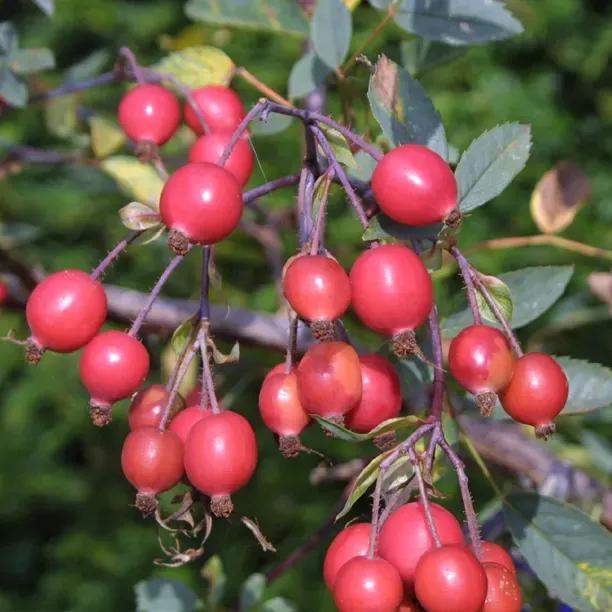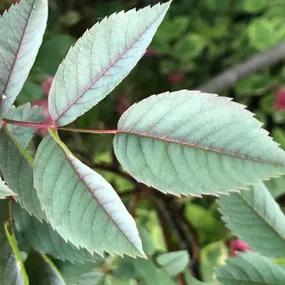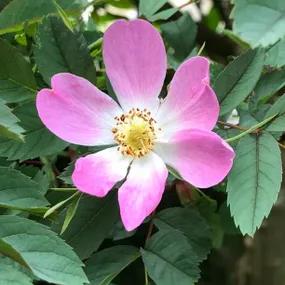Red Leaf Rose Hedge Plants
Honest Delivery PricesRosa glauca
Hedge Plants- Wild rose, grey & purple leaves.
- Grows on chalk & the coast.
- Good for mixed country hedging.
- Likes full sun & will tolerate very poor soil
- Max. Height: 3m
- Bareroot Delivery Only: Nov-Mar.
- RHS Award of Garden Merit
Recommended extras
Description
Glaucous / Red Lead Rose. Rosa glauca Hedging
Delivered by Mail Order Direct from our Nursery with a Year Guarantee
Rosa glauca, the Red Leaved Rose, is an outstanding shrub rose that associates well with other shrubs such as Viburnum plicatum or even a small clematis. It is one of the more beautiful wild roses. Its stems and leaf stalks are purpley-red and the leaves themselves are steely grey, with the colouring of the stems seeping into the recesses of the veins.
The simple, quite sparse flowers in summer are really a bright pink bonus amongst the leaves, and the rose hips that follow are like little cherries. All this makes it a good rose for brightening up mixed country hedges up to about 3 metres high.
For something completely different, plant a single species hedge of Rosa glauca with an underplanting of spring flowering bulbs.
It is suitable for almost any soil that isn't waterlogged and it will grow near the coast.
View our selection of thorny hedging roses or see our full range of hedging plants.
Rosa glauca hedge plants are only delivered bareroot, during winter (Nov-March).
Choosing a size:
When you are ordering Rosa glauca plants for a hedge, we generally recommend that you use plants that are graded at 40/60cm because they are cheaper than large plants, easier to handle, and they will establish well in poor conditions.
Use the larger, 60/80cm tall plants if you want a taller hedge quickly.
All our hedge plants are measured by their height in centimetres above the ground (the roots aren't measured).
Spacing a Rosa glauca hedge:
Plant Rosa glauca hedging at 3 plants per metre, 33cm apart.
History & uses of Red Leaf Rose:
Also listed as Rosa rubrifolia in older books. It has won an RHS Award of Garden Merit for being both attractive and easy to grow.
Planting Instructions
Growing Rosa glauca plants:
These wild roses will grow on most well drained but moist soils, including by the coast and on chalky soil. They are shade tolerant, but won't flower much if they don't get enough sun.
Prepare your site before planting:
Native hedge plants like Rosa glauca are very tough. The only essential preparation is to kill the weeds in a strip a metre wide along the planting site: improving the soil should not be necessary. If your soil is exceptionally poor and dry, then digging in some well rotted manure and/or compost is worthwhile.
Watch our video on how to plant a country hedge for full details.
Remember to water establishing plants during dry weather for at least a year after planting.
Hedge Planting Accessories:
Prepare your site for planting by killing the weeds and grass.
You can buy a hedge planting pack with sheets of mulch fabric and pegs to hold it down.
If your soil quality is poor, we recommend using mycorrhizal "friendly fungi" on the roots of new trees and shrubs.
You can also improve your soil with bonemeal organic fertiliser.
After Care
After you have planted your Rosa glauca hedge, the most important thing to do is water it in dry weather. You will also need to weed around the plants. Watering should be thorough, so the ground is soaked. Let the soil almost dry out before watering again. Watering & weeding will be necessary for at least a year after planting.
Trimming Country hedge plants:
Rosa glauca is a vigorous, native hedging plant that benefits from being cut back hard right after planting, as shown in the country hedge planting video. In the following years, your young hedge should be trimmed lightly once in winter, until it is mature. When it is fully grown, you can clip it at anytime; late winter is ideal.
Special notes on caring for Rosa glauca hedges:
Rosa glauca is a very tough hedge plant that shouldn't need special attention once it has established. If you didn't use a mulch fabric, it is beneficial to mulch around the base of the hedge each year.
Hygiene & Diseases:
Dead, damaged or diseased wood can be pruned off as soon as it appears.
Disinfect your pruning tools between every cut if there is any sign of disease.
Burn or dispose of any diseased material, do not compost it.
After you have planted your Rosa glauca hedge, the most important thing to do is water it in dry weather. You will also need to weed around the plants. Watering should be thorough, so the ground is soaked. Let the soil almost dry out before watering again. Watering & weeding will be necessary for at least a year after planting.
Trimming Country hedge plants:
Rosa glauca is a vigorous, native hedging plant that benefits from being cut back hard right after planting, as shown in the country hedge planting video. In the following years, your young hedge should be trimmed lightly once in winter, until it is mature. When it is fully grown, you can clip it at anytime; late winter is ideal.
Special notes on caring for Rosa glauca hedges:
Rosa glauca is a very tough hedge plant that shouldn't need special attention once it has established. If you didn't use a mulch fabric, it is beneficial to mulch around the base of the hedge each year.
Hygiene & Diseases:
Dead, damaged or diseased wood can be pruned off as soon as it appears.
Disinfect your pruning tools between every cut if there is any sign of disease.
Burn or dispose of any diseased material, do not compost it.




